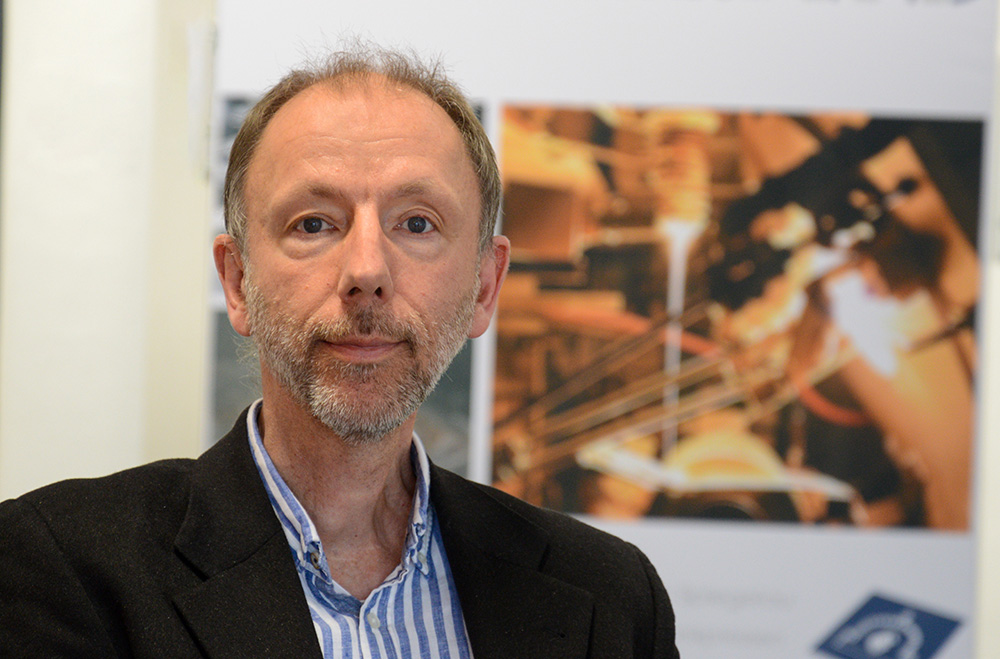
Prof. Dr.-Ing. Thorsten Gerdes
Academic Director
- M. Willert-Porada
- Thorsten Gerdes
- A. Rosin
- A. Saberi
- A. Füller
- Rolf Rascher
- Christine Wünsche
Flexiplant: schmelzebasierte kontinuierliche Herstellung von low TG-Glas-Preformen (mittels Minimeltertechnologie).
In: 87. Glastechnische Tagung
HVG-DGG: Service und Forschung für die Glasherstellung Bremen
- 27.-29.05.2013 (2013)
- Thorsten Gerdes
- K. Kyrgyzbayev
- A. Rosin
- A. Saberi
- A. Füller
- Rolf Rascher
- Christine Wünsche
Aims for the development of new optical glass materials.
In: 1st European Seminar on Precision Optics Manufacturing
Technische Hochschule Deggendorf (THD)/Technologie Campus Teisnach Teisnach
- 01.-02.04.2014 (2014)
- Benedikt Scharfe
- S. Lehmann
- Thorsten Gerdes
- D. Brüggemann
Optical and Mechanical Properties of Highly Transparent Glass-Flake Composites.
In: Journal of Composites Science vol. 3 pg. 1-17
- (2019)
DOI: 10.3390/jcs3040101
- L. Schwinger
- S. Lehmann
- L. Zielbauer
- Benedikt Scharfe
- Thorsten Gerdes
Aluminum Coated Micro Glass Spheres to Increase the Infrared Reflectance.
In: Coatings (Special Issue "Current Research in Thin Film Deposition: Applications, Theory, Processing, and Characterisation") vol. 9 pg. 187
- Harald Zimmermann
- Thorsten Gerdes
Glasproduktion ohne CO2-Emissionen: Eine Utopie?.
In: 1. Fachforum Glas
Kompetenzzentrum Klimaschutz in energieintensiven Industrien Online
- 2020 (2020)
- Tobias Helling
- Thorsten Gerdes
MicroBubble – Energetische Optimierung der Herstellung von Microhohlglaskugeln durch direkte Formung aus der Schmelze. Poster.
In: 7. Tag der Forschung der THD 2020
Technische Hochschule Deggendorf Online
- 23.07.2020 (2020)
- Tobias Helling
- Thorsten Gerdes
- Harald Zimmermann
Mikrohohlglaskugeln - Ein Nischenprodukt mit Potential.
In: Vernissage Klaus Büchler "Kunst trifft Technologie"
Spiegelau
- 03.05.2022 (2022)
- Tobias Helling
- Thorsten Gerdes
- Harald Zimmermann
Direct forming of hollow glass microspheres out of the melt.
In: 26th International Congress on Glass
International Commission on Glass Berlin
- 05.07.2022 (2022)
- Weniamin Yusim
- Harald Zimmermann
- L. Biennek
- Thorsten Gerdes
The use of sodium chloride as a fining agent in all-electrical melting.
In: 26th International Congress on Glass
International Commission on Glass Berlin
- 06.07.2022 (2022)
- Tobias Helling
- Thorsten Gerdes
- Harald Zimmermann
Prozessentwicklung zur direkten Formung von Mikrohohlglassphären aus einer Glasschmelze.
In: BayWISS-Doktorandentreffen
Online
- 20.07.2022 (2022)
- Tobias Helling
- Florian Reischl
- A. Rosin
- Thorsten Gerdes
- Walter Krenkel
Atomization of Borosilicate Glass Melts for the Fabrication of Hollow Glass Microspheres.
In: Processes vol. 11 pg. 2559
- (2023)
DOI: 10.3390/pr11092559
- Tobias Helling
- A. Rosin
- Florian Reischl
- Harald Zimmermann
- Thorsten Gerdes
Influence of process parameters on the direct forming of hollow microspheres from a borosilicate glass melt.
In: 97. Glass-Technology Conference/DGG-Tagung
Deutsche Glastechnische Gesellschaft e.V. Aachen
- 27.-29.05.2024 (2024)